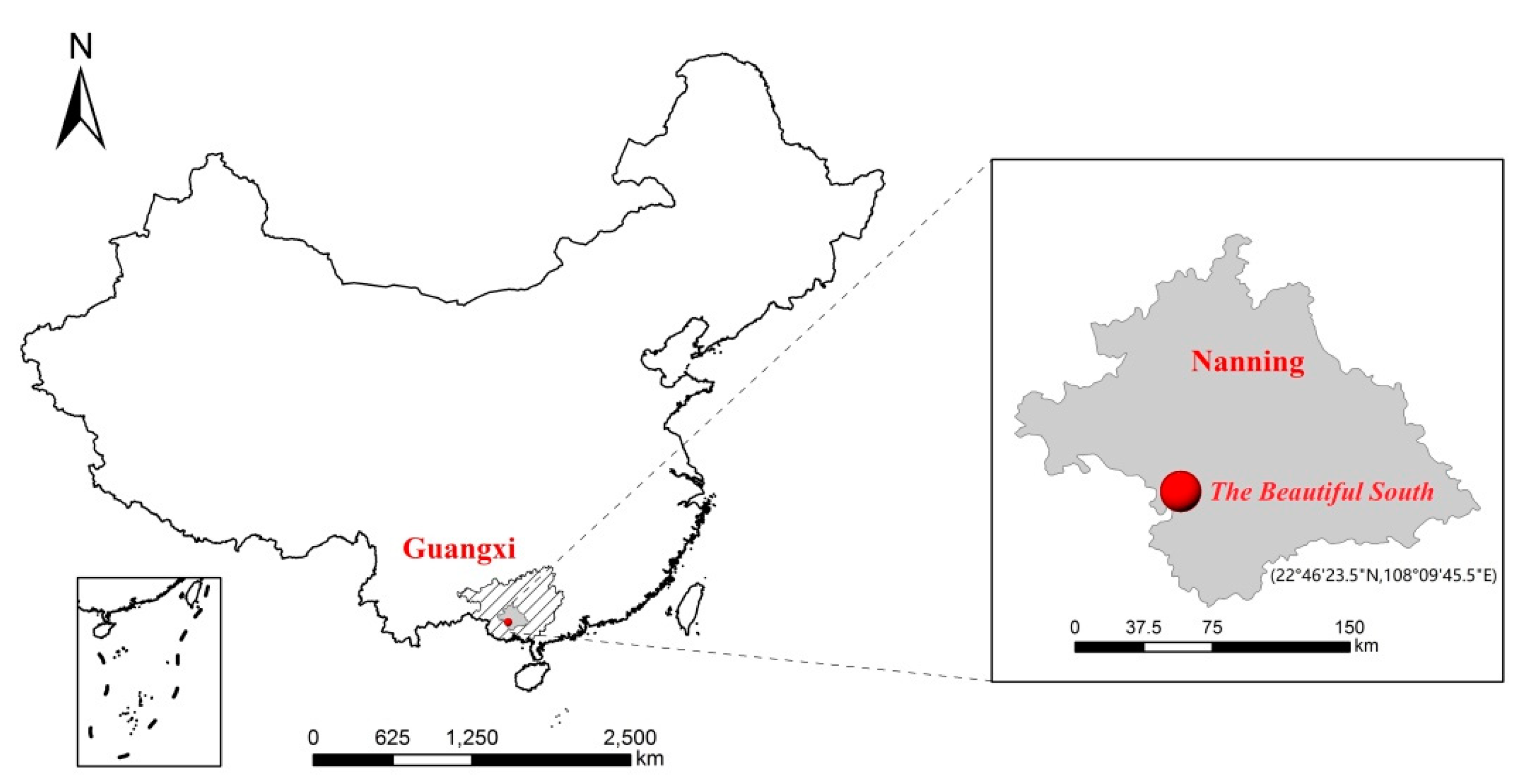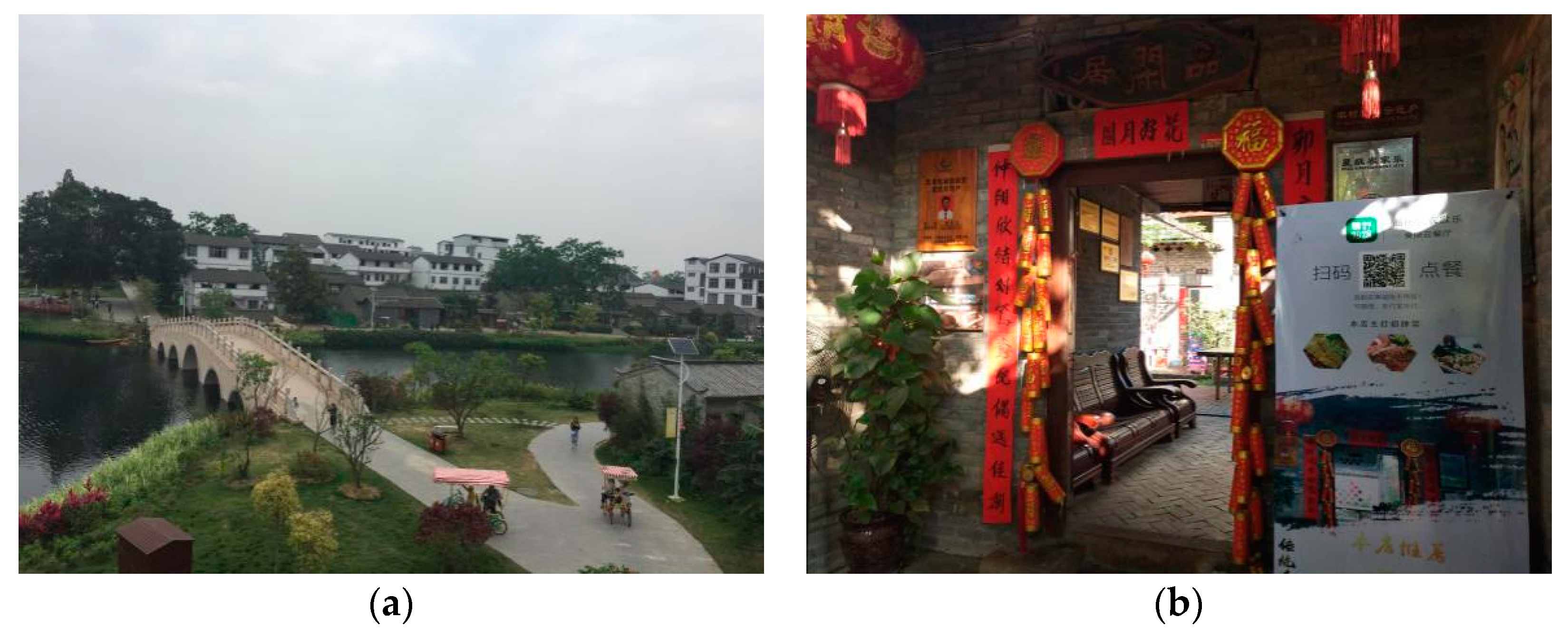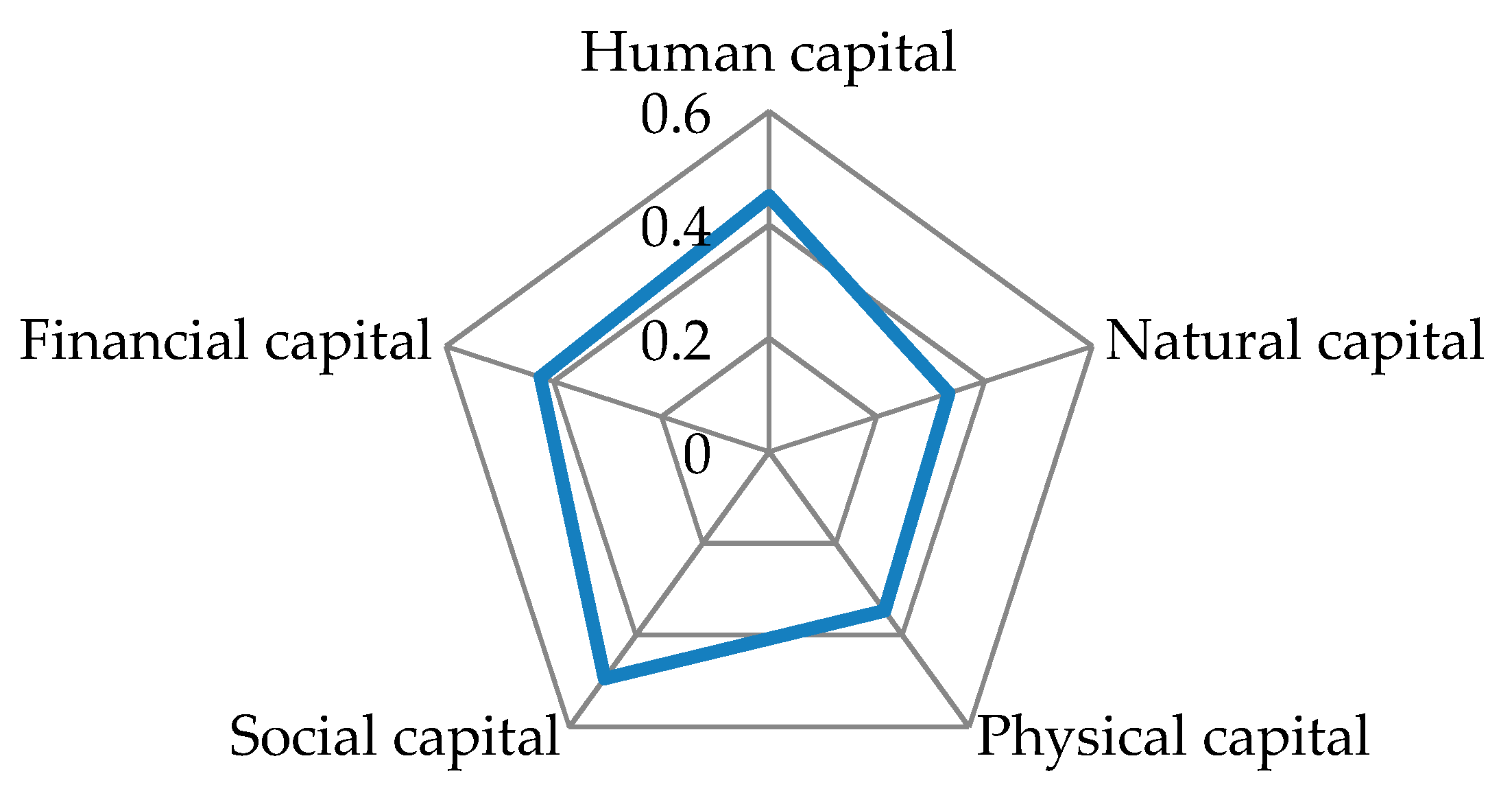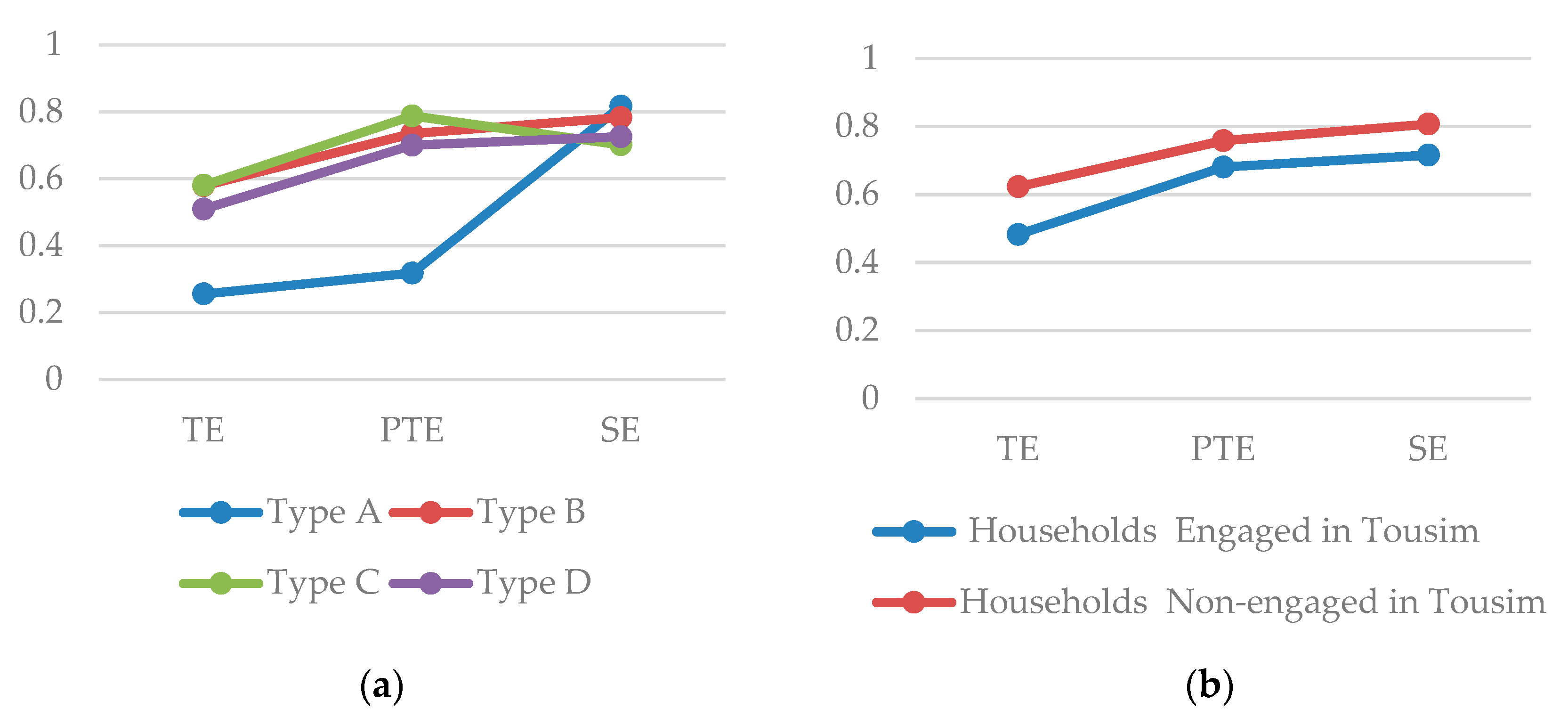Sustainable Livelihood Capital and Strategy in Rural Tourism Households: A Seasonality Perspective
Abstract
:1. Introduction
2. Methods
2.1. Case Study Area
2.2. Data Source and Processing
2.3. Rural Household Categories
2.4. Livelihood Capital Index
2.5. Entropy Method and LCI
2.6. Efficiency Assessment of Livelihood Capital
3. Results
3.1. Household Livelihood Assets
3.2. Livelihood Capital of Various Household Types
3.2.1. Natural Capital
3.2.2. Physical Capital
3.2.3. Human Capital
3.2.4. Social Capital
3.2.5. Financial Capital
3.3. Livelihood Capital of Tourism Households
3.4. Seasonality Impacts Tourism-Engaged Households
3.5. Efficiency Assessment of Livelihood Capitals
4. Discussion and Conclusions
Author Contributions
Funding
Conflicts of Interest
References
- Lulia, C.M.; Camelia, F.O.; Rezhen, H.; Felix, H.A.; Andra, P.; Gabriela, O.C.; Alexandru, T.; Ramona, L. Local Residents’ Attitude toward Sustainable Rural Tourism Development. Sustainability 2016, 8, 100. [Google Scholar]
- Sharpley, R. Rural tourism and the challenge of tourism diversification: The case of Cyprus. Tour. Manag. 2002, 23, 233–244. [Google Scholar] [CrossRef]
- Iorio, M.; Corsale, A. Rural tourism and livelihood strategies in Romania. J. Rural Stud. 2010, 26, 152–162. [Google Scholar] [CrossRef]
- Snyder, K.A.; Sulle, E.B. Tourism in Maasai communities: A chance to improve livelihoods? J. Sustain. Tour. 2011, 19, 935–951. [Google Scholar] [CrossRef]
- Wu, M.Y.; Pearce, P.L. Host tourism aspirations as a point of departure for the sustainable livelihoods approach. J. Sustain. Tour. 2014, 22, 440–460. [Google Scholar] [CrossRef]
- Nyaupane, G.P.; Poudel, S. Linkages among Biodiversity, Livelihood, and Tourism. Ann. Tour. Res. 2011, 38, 1344–1366. [Google Scholar] [CrossRef]
- Shen, F.; Hughey, K.F.; Simmons, D.G. Connecting the sustainable livelihoods approach and tourism: A review of the literature. J. Hosp. Tour. Manag. 2008, 15, 19–31. [Google Scholar] [CrossRef]
- Diniz, F.H.; Kok, K.; Hoogstra-Klein, M.A.; Arts, B. Mapping future changes in livelihood security and environmental sustainability based on perceptions of small farmers in the Brazilian Amazon. Ecol. Soc. 2015, 20, 26. [Google Scholar] [CrossRef]
- Ellis, F. Rural Livelihoods and Diversity in Developing Countries; Oxford University Press: New York, NY, USA, 2000. [Google Scholar]
- Chambers, R.; Conway, G. Sustainable Rural Livelihoods: Practical Concepts for the 21st Century; Institute of Development Studies: Brighton, UK, 1992. [Google Scholar]
- Carney, D. Sustainable Livelihoods Approaches: Progress and Possibilities for Change; Department for International Development: London, UK, 2003. [Google Scholar]
- Su, M.M.; Wall, G.; Wang, Y.A.; Jin, M. Livelihood sustainability in a rural tourism destination-Hetu Town, Anhui Province, China. Tour. Manag. 2019, 71, 272–281. [Google Scholar] [CrossRef]
- Conroy, C.; Litvinoff, M. The Greening of Aid: Sustainable Livelihoods in Practice; Routledge: London, UK, 2013. [Google Scholar]
- Ashley, C. The Impacts of Tourism on Rural Livelihoods: Namibia’s Experience; Overseas Development Institute: London, UK, 2000. [Google Scholar]
- Melita, A.W.; Mendlinger, S. The impact of tourism revenue on the local communities’ livelihood: A case study of Ngorongoro Conservation Area, Tanzania. J. Serv. Sci. Manag. 2013, 6, 117. [Google Scholar] [CrossRef]
- Nepal, S.K. Sustainable tourism, protected areas and livelihood needs of local communities in developing countries. Int. J. Sustain. Dev. World Ecol. 1997, 4, 123–134. [Google Scholar] [CrossRef]
- Anup, K.; Parajuli, R.B.T. Tourism and its impact on livelihood in Manaslu conservation area, Nepal. Environ. Dev. Sustain. 2014, 16, 1053–1063. [Google Scholar]
- León, Y.M. The impact of tourism on rural livelihoods in the Dominican Republic’s coastal areas. J. Dev. Stud. 2007, 43, 340–359. [Google Scholar] [CrossRef]
- Lee, M.H. Tourism and sustainable livelihoods: The case of Taiwan. Third World Q. 2008, 29, 961–978. [Google Scholar] [CrossRef]
- Mbaiwa, J.E.; Sakuze, L.K. Cultural tourism and livelihood diversification: The case of Gcwihaba Caves and XaiXai village in the Okavango Delta, Botswana. J. Tour. Cult. Chang. 2009, 7, 61–75. [Google Scholar] [CrossRef]
- Mbaiwa, J.E.; Stronza, A.L. The effects of tourism development on rural livelihoods in the Okavango Delta, Botswana. J. Sustain. Tour. 2010, 18, 635–656. [Google Scholar] [CrossRef]
- Lundtorp, S. Chapter 3-Measuring tourism seasonality. In Seasonality in Tourism; Baum, T., Lundtorp, S., Eds.; Routledge: New York, NY, USA, 2011; pp. 23–50. [Google Scholar]
- Banki, M.B.; Ismail, H.N.; Muhamad, I.B. Coping with seasonality: A case study of family owned micro tourism businesses in Obudu Mountain Resort in Nigeria. Tour. Manag. Perspect. 2016, 18, 141–152. [Google Scholar] [CrossRef]
- Butler, R. Chapter 2-Seasonality in tourism: Issues and implications. In Seasonality in Tourism; Baum, T., Lundtorp, S., Eds.; Routledge: New York, NY, USA, 2011; pp. 5–21. [Google Scholar]
- Commons, J.; Page, S. Chapter 10-Managing Seasonality in Peripheral Tourism Regions: The Case of Northland, New Zealand. In Seasonality in Tourism; Baum, T., Lundtorp, S., Eds.; Pergamon: Oxford, UK, 2001; pp. 153–172. [Google Scholar]
- Baum, T.; Hagen, L. Responses to seasonality: The experiences of peripheral destinations. Int. J. Tour. Res. 1999, 1, 299–312. [Google Scholar] [CrossRef]
- Goulding, P.J.; Baum, T.G.; Morrison, A.J. Seasonal Trading and Lifestyle Motivation. J. Q. Assur. Hosp. Tour. 2005, 5, 209–238. [Google Scholar] [CrossRef]
- Koenig–Lewis, N.; Bischoff, E.E. Developing Effective Strategies for Tackling Seasonality in the Tourism Industry. Tour. Hosp. Plan. Dev. 2010, 7, 395–413. [Google Scholar] [CrossRef]
- Duval, D.T. When buying into the business, we knew it was seasonal: Perceptions of seasonality in Central Otago, New Zealand. Int. J. Tour. Res. 2004, 6, 325–337. [Google Scholar] [CrossRef]
- Jang, S.S. Mitigating tourism seasonality: A quantitative approach. Ann. Tour. Res. 2004, 31, 819–836. [Google Scholar] [CrossRef]
- Getz, D.; Nilsson, P.A. Responses of family businesses to extreme seasonality in demand: The case of Bornholm, Denmark. Tour. Manag. 2004, 25, 17–30. [Google Scholar] [CrossRef]
- Goulding, P.; Gunn, G. A Supply Side Study of Tourism Seasonality: A case study of tourism businesses in the Scottish Borders. In Proceedings of the 9th Annual CHME Hospitality Research Conference, 26–27 April 2000; University of Huddersfield: Huddersfield, UK, 2000; pp. 361–369. [Google Scholar]
- Open Ceremony of “Beautiful South” Zhongliang Village Scenic Spot in Shibu. Available online: http://www.gxnews.com.cn/staticpages/20061003/newgx4521ded5-828791.shtml (accessed on 2 August 2019). (In Chinese).
- Zhongliang Village of Xixiangtang District in Nanning City: Building Beautiful Zhongliang with Civilized Rural Scenery. Available online: http://www.gxnews.com.cn/staticpages/20181012/newgx5bbff43a-17712283.shtml?pcview=1 (accessed on 1 August 2019). (In Chinese).
- Ma, J.H.; Zhang, J.; Li, L.; Zeng, Z.J.; Sun, J.R.; Zhou, Q.L.; Zhang, Y.L. Study on Livelihood Assets–Based Spatial Differentiation of the Income of Natural Tourism Communities. Sustainability 2018, 10, 353. [Google Scholar] [CrossRef]
- Li, G.; Fang, C.; Qiu, D.; Wang, L. Impact of farmer households’ livelihood assets on their options of economic compensation patterns for cultivated land protection. J. Geogr. Sci. 2014, 24, 331–348. [Google Scholar] [CrossRef]
- Nurul Islam, G.M.; Yew, T.S.; Viswanathan, K.K. Poverty and livelihood impacts of community based fisheries management in Bangladesh. Ocean. Coast Manag. 2014, 96, 123–129. [Google Scholar] [CrossRef]
- Fang, Y.P.; Fan, J.; Shen, M.Y.; Song, M.Q. Sensitivity of livelihood strategy to livelihood capital in mountain areas: Empirical analysis based on different settlements in the upper reaches of the Minjiang River, China. Ecol. Indic. 2014, 38, 225–235. [Google Scholar] [CrossRef]
- Tao, T.C.; Wall, G. Tourism as a sustainable livelihood strategy. Tour. Manag. 2009, 30, 90–98. [Google Scholar] [CrossRef]
- Zou, Z.H.; Yi, Y.; Sun, J.N. Entropy method for determination of weight of evaluating indicators in fuzzy synthetic evaluation for water quality assessment. J. Environ. Sci. 2006, 18, 1020–1023. [Google Scholar] [CrossRef]
- Shannon, C.E. A mathematical theory of communication. Bell Syst. Tech. J. 1948, 27, 379–423. [Google Scholar] [CrossRef]
- Kapur, J.N.; Kesavan, H.K. Entropy optimization principles and their applications. In Entropy and Energy Dissipation in Water Resources; Springer: Dordrecht, The Netherlands, 1992; pp. 3–20. [Google Scholar]
- Ma, J.; Fan, Z.P.; Huang, L.H. A subjective and objective integrated approach to determine attribute weights. Eur. J. Oper. Res. 1999, 112, 397–404. [Google Scholar] [CrossRef]
- Charnes, A.; Cooper, W.W.; Rhodes, E. Measuring the efficiency of decision making units. Eur. J. Oper. Res. 1978, 2, 429–444. [Google Scholar] [CrossRef]
- Banker, R.D.; Charnes, A.; Cooper, W.W. Some models for estimating technical and scale inefficiencies in data envelopment analysis. Manag. Sci. 1984, 30, 1078–1092. [Google Scholar] [CrossRef]
- Yin, J.; Tan, Q. Study on Urban Efficiency Measurement and Spatiotemporal Evolution of Cities in Northwest China Based on the DEA–Malmquist Model. Sustainability 2019, 11, 434. [Google Scholar] [CrossRef]
- Jia, C.; Zhang, L.; Yang, X.; Li, G. The impact of tourism development on changes of households’ livelihood and community tourism effect: A case study based on the perspective of tourism development mode. Geogr. Res. 2017, 36, 1709–1724. (In Chinese) [Google Scholar]
- Wang, J.; Zhang, Y.; Shi, L. Evaluation index system of sustainable livelihoods ecotourism strategy: A case study of wangjiazhai community in baiyangdian wetland nature reserve, Hebei. Acta Ecol. Sin. 2014, 34, 2388–2400. (In Chinese) [Google Scholar]
- Shi, Y.; Li, J. The Multifunctional Development of Rural Tourism and the Rural Sustainable Livelihood: A Collaborative Study. Tour. Trib. 2018, 33, 15–26. (In Chinese) [Google Scholar]
- Buultjens, J.; Gale, D.; White, N.E. Synergies between Australian indigenous tourism and ecotourism: Possibilities and problems for future development. J. Sustain. Tour. 2010, 18, 497–513. [Google Scholar] [CrossRef]
- Keung Wong, D.F.; Li, C.Y.; Song, H.X. Rural migrant workers in urban China: Living a marginalised life. Int. J. Soc. Wel. 2007, 16, 32–40. [Google Scholar] [CrossRef]
- He, A.; Yang, X.; Chen, J.; Wang, Z. Impact of Rural Tourism Development on Farmer’s Livelihoods: A Case Study of Rural Tourism Destinations in Northern Slop of Qinling Mountains. Econo. Geogr. 2014, 34, 174–181. (In Chinese) [Google Scholar]
- Chao, X.; Shen, K. Urban–Rural Income Disparity, Labor Quality and Economic Growth in China. Econ. Res. J. 2014, 49, 30–43. (In Chinese) [Google Scholar]
- Hinch, T.D.; Jackson, E.L. Leisure Constraints Research: Its Value as a Framework for Understanding Tourism Seasonability. Curr. Issues Tour. 2000, 3, 87–106. [Google Scholar] [CrossRef]
- Rodríguez Díaz, M.; Espino Rodríguez, T. Determining the sustainability factors and performance of a tourism destination from the stakeholders’ perspective. Sustainability 2016, 8, 951. [Google Scholar] [CrossRef]
- Su, M.M.; Wall, G.; Xu, K. Heritage tourism and livelihood sustainability of a resettled rural community: Mount Sanqingshan World Heritage Site, China. J. Sustain Tour. 2016, 24, 735–757. [Google Scholar] [CrossRef]




| Livelihood Capital | Measurement Indicators | Values | Weight Values |
|---|---|---|---|
| Natural capital | Agricultural acreage | Total agricultural acreage in survey year | 0.176 |
| Cultivated land quality | High quality = 1, Good = 0.67, General = 0.33, None = 0 | 0.150 | |
| Physical capital | Housing quality | Concrete house = 1, Brick and tile house = 0.75, Wooden house = 0.50, Soil building = 0.25 | 0.029 |
| Living space | Total living space in survey year | 0.066 | |
| Means of production | Building = 1, Freight motor vehicles = 0.75, Agricultural machinery = 0.50, Motorcycle/electric vehicle = 0.25 | 0.029 | |
| Life supplies | Car = 1, Computer = 0.75, Daily household appliances = 0.5, Others = 0.25 | 0.028 | |
| Human capital | Age of household members | 19–60 years old = 1, 13–18 years old = 0.5, Under 12 & over 60 = 0 | 0.011 |
| Education of household members | University and above = 1, High school or technical secondary school = 0.8, Junior high school = 0.6, Primary school = 0.4, Uneducated = 0.2 | 0.021 | |
| Health status of household members | Good = 1, Can take care of themselves = 0.5, Cannot care for themselves = 0 | 0.013 | |
| Social capital | Social networking status | Have social relations = 1, No social relation = 0 | 0.153 |
| Participation in community activities | Often = 1, Sometimes = 0.5, Rarely = 0 | 0.087 | |
| Access to support | Support from relatives = 1, Support from neighbors and friends = 0.5, None = 0 | 0.032 | |
| Access to training | Yes = 1, No = 0 | 0.111 | |
| Financial capital | Annual household income | Total household income in survey year | 0.033 |
| Access to loans | Easy = 1.0, Normal = 0.5, Hard = 0 | 0.060 |
| Capital Type | Evaluation Indicator | Type A | Type B | Type C | Type D | ||||
|---|---|---|---|---|---|---|---|---|---|
| Natural capital | Agricultural acreage | 0.523 | 0.328 | 0.361 | 0.292 | 0.333 | 0.237 | 0.115 | 0.072 |
| Cultivated land quality | 0.753 | 0.442 | 0.445 | 0.167 | |||||
| Physical capital | Housing quality | 0.23 | 0.417 | 0.354 | 0.475 | 0.408 | 0.556 | 0.395 | 0.507 |
| Living space | 0.037 | 0.270 | 0.342 | 0.329 | |||||
| Means of production | 0.208 | 0.238 | 0.278 | 0.253 | |||||
| Life supplies | 0.500 | 0.537 | 0.542 | 0.576 | |||||
| Human capital | Age of household members | 0.324 | 0.533 | 0.42 | 0.429 | 0.532 | 0.507 | 0.526 | 0.524 |
| Education of household members | 0.263 | 0.414 | 0.544 | 0.523 | |||||
| Health status of household members | 0.250 | 0.422 | 0.533 | 0.531 | |||||
| Social capital | Social networking status | 0.402 | 0.250 | 0.38 | 0.294 | 0.678 | 0.917 | 0.518 | 0.458 |
| Participation in community activities | 0.250 | 0.368 | 0.417 | 0.479 | |||||
| Access to support | 0.333 | 0.627 | 0.583 | 0.611 | |||||
| Access to training | 0.750 | 0.441 | 0.583 | 0.604 | |||||
| Financial capital | Annual household income | 0.395 | 0.208 | 0.447 | 0.497 | 0.408 | 0.467 | 0.449 | 0.488 |
| Access to loans | 0.500 | 0.419 | 0.375 | 0.427 | |||||
| Livelihood capital index | 1874 | 1962 | 2359 | 2003 | |||||
| Household proportion in survey | 3.0% | 51.5% | 9.1% | 36.4% | |||||
| Livelihood Capital | Livelihood Capital Index | Households not Engaged in Tourism | Households Engaged in Tourism | ||
|---|---|---|---|---|---|
| Natural capital | Agricultural acreage | 0.376 | 0.309 | 0.194 | 0.129 |
| Cultivated land quality | 0.455 | 0.271 | |||
| Physical capital | Housing quality | 0.356 | 0.511 | 0.381 | 0.477 |
| Living space | 0.263 | 0.313 | |||
| Means of production | 0.256 | 0.239 | |||
| Life supplies | 0.511 | 0.581 | |||
| Human capital | Age | 0.439 | 0.448 | 0.487 | 0.494 |
| Education | 0.434 | 0.482 | |||
| Health | 0.440 | 0.488 | |||
| Social capital | Social networking | 0.417 | 0.414 | 0.490 | 0.405 |
| Participation in community activities | 0.345 | 0.459 | |||
| Access to support | 0.586 | 0.626 | |||
| Access to training | 0.431 | 0.595 | |||
| Financial capital | Annual household income | 0.387 | 0.478 | 0.486 | 0.485 |
| Access to loans | 0.336 | 0.486 | |||
| Livelihood capital index | 1975 | 2038 | |||
| Seasonality | Off-Season/Household | Peak-Season/Household | ||||||||
|---|---|---|---|---|---|---|---|---|---|---|
| Livelihood strategies | Type A | Type B | Type C | Type D | Sum | Type A | Type B | Type C | Type D | Sum |
| Agriculture | 2 | 2 | 0 | 9 | 13 | 2 | 2 | 0 | 2 | 6 |
| Laboring work | 1 | 20 | 1 | 22 | 44 | 1 | 19 | 0 | 4 | 24 |
| Microbusiness | 0 | 0 | 4 | 8 | 12 | 0 | 0 | 4 | 10 | 14 |
| Tourism | 0 | 8 | 1 | 25 | 34 | 2 | 20 | 4 | 48 | 74 |
© 2019 by the authors. Licensee MDPI, Basel, Switzerland. This article is an open access article distributed under the terms and conditions of the Creative Commons Attribution (CC BY) license (http://creativecommons.org/licenses/by/4.0/).
Share and Cite
Su, Z.; Aaron, J.R.; Guan, Y.; Wang, H. Sustainable Livelihood Capital and Strategy in Rural Tourism Households: A Seasonality Perspective. Sustainability 2019, 11, 4833. https://doi.org/10.3390/su11184833
Su Z, Aaron JR, Guan Y, Wang H. Sustainable Livelihood Capital and Strategy in Rural Tourism Households: A Seasonality Perspective. Sustainability. 2019; 11(18):4833. https://doi.org/10.3390/su11184833
Chicago/Turabian StyleSu, Zhen, Joshua R. Aaron, Yang Guan, and Hongchen Wang. 2019. "Sustainable Livelihood Capital and Strategy in Rural Tourism Households: A Seasonality Perspective" Sustainability 11, no. 18: 4833. https://doi.org/10.3390/su11184833
APA StyleSu, Z., Aaron, J. R., Guan, Y., & Wang, H. (2019). Sustainable Livelihood Capital and Strategy in Rural Tourism Households: A Seasonality Perspective. Sustainability, 11(18), 4833. https://doi.org/10.3390/su11184833







